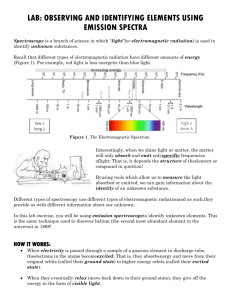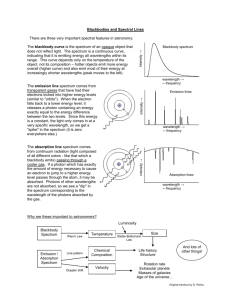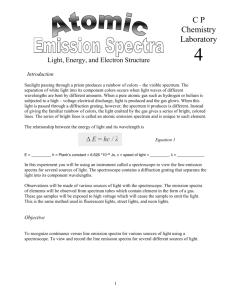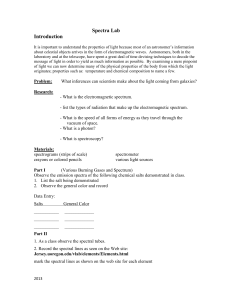Lab 4-2 Atomic Emission Spectroscopy
advertisement
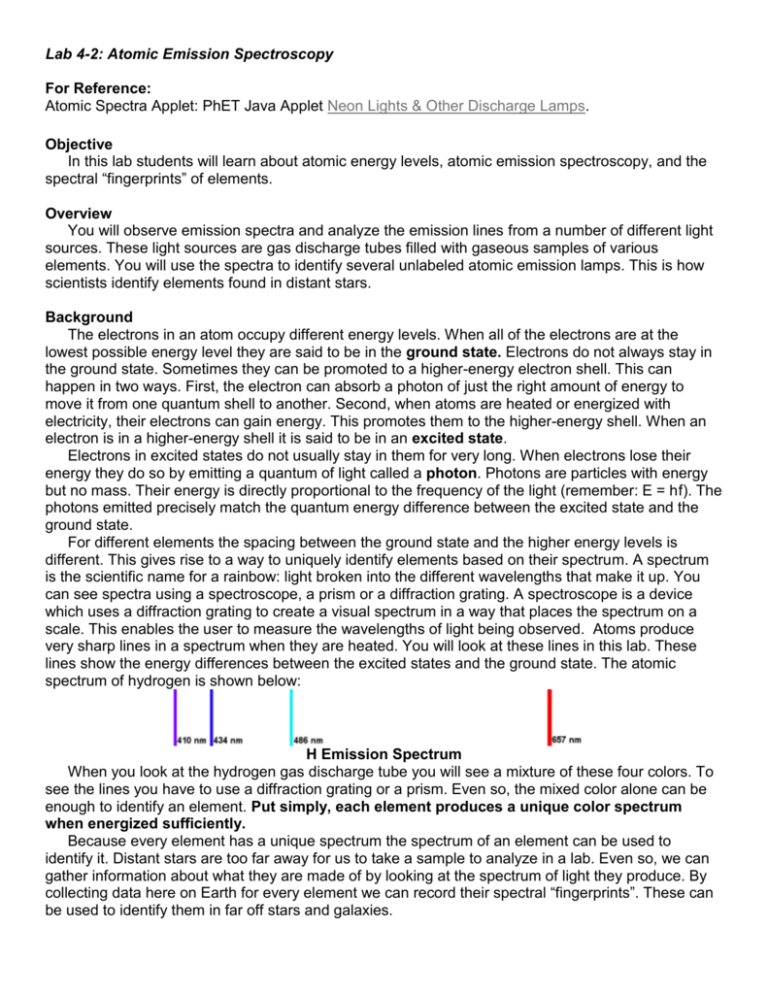
Lab 4-2: Atomic Emission Spectroscopy For Reference: Atomic Spectra Applet: PhET Java Applet Neon Lights & Other Discharge Lamps. Objective In this lab students will learn about atomic energy levels, atomic emission spectroscopy, and the spectral “fingerprints” of elements. Overview You will observe emission spectra and analyze the emission lines from a number of different light sources. These light sources are gas discharge tubes filled with gaseous samples of various elements. You will use the spectra to identify several unlabeled atomic emission lamps. This is how scientists identify elements found in distant stars. Background The electrons in an atom occupy different energy levels. When all of the electrons are at the lowest possible energy level they are said to be in the ground state. Electrons do not always stay in the ground state. Sometimes they can be promoted to a higher-energy electron shell. This can happen in two ways. First, the electron can absorb a photon of just the right amount of energy to move it from one quantum shell to another. Second, when atoms are heated or energized with electricity, their electrons can gain energy. This promotes them to the higher-energy shell. When an electron is in a higher-energy shell it is said to be in an excited state. Electrons in excited states do not usually stay in them for very long. When electrons lose their energy they do so by emitting a quantum of light called a photon. Photons are particles with energy but no mass. Their energy is directly proportional to the frequency of the light (remember: E = hf). The photons emitted precisely match the quantum energy difference between the excited state and the ground state. For different elements the spacing between the ground state and the higher energy levels is different. This gives rise to a way to uniquely identify elements based on their spectrum. A spectrum is the scientific name for a rainbow: light broken into the different wavelengths that make it up. You can see spectra using a spectroscope, a prism or a diffraction grating. A spectroscope is a device which uses a diffraction grating to create a visual spectrum in a way that places the spectrum on a scale. This enables the user to measure the wavelengths of light being observed. Atoms produce very sharp lines in a spectrum when they are heated. You will look at these lines in this lab. These lines show the energy differences between the excited states and the ground state. The atomic spectrum of hydrogen is shown below: H Emission Spectrum When you look at the hydrogen gas discharge tube you will see a mixture of these four colors. To see the lines you have to use a diffraction grating or a prism. Even so, the mixed color alone can be enough to identify an element. Put simply, each element produces a unique color spectrum when energized sufficiently. Because every element has a unique spectrum the spectrum of an element can be used to identify it. Distant stars are too far away for us to take a sample to analyze in a lab. Even so, we can gather information about what they are made of by looking at the spectrum of light they produce. By collecting data here on Earth for every element we can record their spectral “fingerprints”. These can be used to identify them in far off stars and galaxies. Materials 1. 2. 3. 4. Element gas emission tubes with power supplies diffraction gratings, and/or spectroscopes paper & colored pencils Spectrum Data Sheet Safety The atomic emission lamps use high voltage sources to energize the atoms in the discharge tubes. These voltages are 5,000 volts or more. This voltage could be deadly: never put a finger, pencil, or any other object into the socket of the atomic emission lamps! The discharge tubes are fragile and should be handled with care. Do not remove them from the lamp fixtures and do not move the fixtures to avoid breaking the tubes. Always turn off the lamps when you are not using them to save power. Procedure Read all instructions completely before beginning your work in the lab. Turn in the Lab Report Sheet with spectrograph drawings attached. Observing Atomic Emission Spectra Representative Wavelength Color Wavelength (nm) Region (nm) 1. Obtain a copy of the atomic emission spectra Violet 420 400 - 440 worksheet. You will use this to record your lab Blue 455 440 - 470 data. 2. Near the top of the page (with the long side Blue-green 480 470 - 490 held vertical) write the title: Atomic Emission Green 525 490 - 560 Spectrograms. Also write your name. Yellow-green 565 560 - 570 3. Your copy is not in color. Using the chart at right, color the reference spectrum at the top of Yellow 580 570 - 585 the page so that you will have a complete Orange 620 585 - 630 visible spectrum in color with which to Red 660 630 - 700 compare the line spectra of the elements you will examine. 4. Obtain a spectroscope. This device will split the light produced by the elements in the tubes into a spectrum you can see. You will see a small number scale inside. This will make it easier to assign numerical values to the wavelengths of the light. 5. Observe the spectra of all available elements. To prolong their usefulness please operate them by cycling them on and off for 30 seconds at a time. Turn the lamps on for 30 seconds and off for 30 seconds. 6. Record the emission spectrum of each element on the rectangles of your Atomic Emission Spectra page. Label each spectrum carefully! Reference spectra can be viewed online at http://astro.u-strasbg.fr/~koppen/discharge/. Be careful to place the lines of the spectrum as close as possible to the correct numerical value for the wavelength. Use your colored spectrum at the top of the page to line up the lines as best you as can so that you can estimate the wavelength of the lines you draw. 7. Once everyone has had a chance to record all of the atomic emission spectra, you will observe, compare and identify the unknown element. Lab 4-2: Atomic Emission Spectroscopy Lab Report Sheet Name: ______________________ Per _____ Using color pencils to color in the visible spectrum. Questions 1. What is a spectroscope and what is it for? Remember, you used a spectroscope in this lab. 2. You observed the spectral lines for a variety of different elements. What is happening within an atom that causes it to emit light in specific lines in a spectrum? 3. Why did each of the different elements have a different emission spectrum? Explain your answer. 4. What was the identity of the unknown lamp? 5. How can you use the emission spectrum of an element to identify it? 6. Why do the elements in the tubes have to have high voltage electricity run through them before the colored light is emitted? In other words, why don't the cold, un-energized tubes glow? 7. Carefully determine the wavelength of each of the emission lines in the spectra of the element hydrogen. Calculate the frequency (c = λf) and the energy (E = hf) for each of the lines for the two elements. List the results in order from the least energetic to the most energetic photons. Show your calculations. frequency energy Calculations Wavelength Color of emission line Wavelength (m) Frequency (Hz) Energy (J) 8. In your own words, write a short explanation (2 or more paragraphs) of how an electron absorbs energy and re-emits it as light and why different elements have different spectra.



